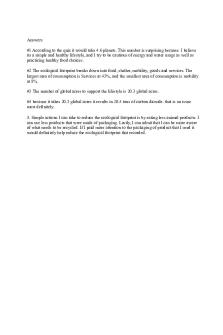Bronfenbrenner’s ecological theory PDF

| Title | Bronfenbrenner’s ecological theory |
|---|---|
| Author | Elizabeth Waldron |
| Course | Human Development |
| Institution | Flinders University |
| Pages | 2 |
| File Size | 35.9 KB |
| File Type | |
| Total Downloads | 93 |
| Total Views | 141 |
Summary
A summary of Bronfenbrenner's Ecological theory, with examples at each level...
Description
Bronfenbrenner’s ecological theory ●
Bronfenbrenner’s ecological theory ○ Framework to recognise contextual influences on child development ■ Concentric circles expanding from the system within the child’s body all the way out to include social systems and time ■ This framework enables researchers to examine several contexts in which to view their data ○ There are 6 nested systems (+ time): ■ Biosystem ● Genetic information ● Physiology ● Biological system are plastic, they can change over time ■ Individual ● A unique individual ○ E.g. temperament, aptitude, activity levels, beliefs, attitudes, etc. ● Humans are active in shaping and selectively accessing other systems ■ Microsystem ● The individual’s immediate context ● Environment that person directly accesses ○ People and animals (agents) ■ E.g. immediate family, pets ○ Objects ■ Neighbourhood play area, household furniture ○ Events ■ Accidents, divorce, etc. ■ Mesosystem ● Relationship between agents/objects/events within the microsystem ● If there is consistency it usually exerts a positive influence on development ○ E.g. school supporting the cultural upbringing of the child by the parents ● If there is a conflict it is usually a negative influence ○ E.g. bringing culture from home into school can result in bullying ○ E.g. level of consistency between parents (good cop/bad cop) ○ E.g. conflict between parents and child’s educators ■ Exosystem ● Factors and activities that influence the person indirectly ○ E.g. the existence of a job that the father goes to influences how much time the child spends with the father, even though the job does not directly interact with the child
■
■
Macrosystem ● Values, customs, practices of culture, laws and infrastructure of society ● Often ingrained and reinforced even before birth ○ E.g. gendered toys, specialised baby equipment, collective vs. individualistic cultures Chronosystem (time) ● Marks the changes that happen over time ○ Individual change ■ E.g. personal growth ○ Societal changes ■ E.g. historical shifts...
Similar Free PDFs

Ecological footprint
- 1 Pages

Ecological Succession
- 4 Pages

Ecological Succession
- 5 Pages

Ecological Footprint Worksheet
- 2 Pages

23 Ecological Relationships-S
- 8 Pages

Ecological succession lab
- 5 Pages

AGRO ECOLOGICAL REGIONS OF INDIA
- 5 Pages

Ecological Footprint Activity
- 3 Pages

Ecological theories of crime
- 4 Pages

Ecological Relationships Answers
- 3 Pages
Popular Institutions
- Tinajero National High School - Annex
- Politeknik Caltex Riau
- Yokohama City University
- SGT University
- University of Al-Qadisiyah
- Divine Word College of Vigan
- Techniek College Rotterdam
- Universidade de Santiago
- Universiti Teknologi MARA Cawangan Johor Kampus Pasir Gudang
- Poltekkes Kemenkes Yogyakarta
- Baguio City National High School
- Colegio san marcos
- preparatoria uno
- Centro de Bachillerato Tecnológico Industrial y de Servicios No. 107
- Dalian Maritime University
- Quang Trung Secondary School
- Colegio Tecnológico en Informática
- Corporación Regional de Educación Superior
- Grupo CEDVA
- Dar Al Uloom University
- Centro de Estudios Preuniversitarios de la Universidad Nacional de Ingeniería
- 上智大学
- Aakash International School, Nuna Majara
- San Felipe Neri Catholic School
- Kang Chiao International School - New Taipei City
- Misamis Occidental National High School
- Institución Educativa Escuela Normal Juan Ladrilleros
- Kolehiyo ng Pantukan
- Batanes State College
- Instituto Continental
- Sekolah Menengah Kejuruan Kesehatan Kaltara (Tarakan)
- Colegio de La Inmaculada Concepcion - Cebu





